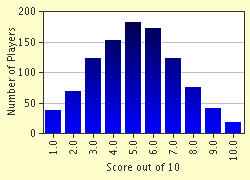Quiz Answer Key and Fun Facts
1. Which queen was known as 'Bloody Mary'?
2. What did the Bank of England issue for the first time in 1791?
3. Who was the only English pope?
4. Who made the first non-stop transatlantic crossing in an aeroplane?
5. Which tax was levied between 1696 and 1851?
6. What was founded in the reign of Henry VII for the protection of Royalty?
7. How long did the Hundred Years' War last?
8. What was the name of the ship commanded by Sir Francis Drake that set sail in 1577 to circumnavigate the globe?
9. What was the name of the first steam engine to run between Stockton and Darlington?
10. Of which tribe was Boudicca queen?
Source: Author
sunfloweruk23
This quiz was reviewed by FunTrivia editor
bloomsby before going online.
Any errors found in FunTrivia content are routinely corrected through our feedback system.


